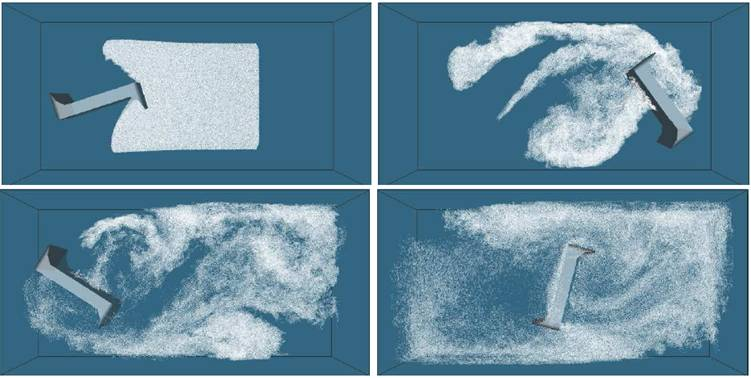A Fast Variational Framework for Accurate Solid-Fluid Coupling

A paddle swirls through smoke, simulated at 3 seconds per frame, 20 times faster than equivalent tetrahedral meshes, yet retains greater vorticial detail. A reduced resolution version runs interactively, with results comparable to tet meshes.
Abstract: Physical simulation has emerged as a compelling animation technique, yet current approaches to coupling simulations of fluids and solids with irregular boundary geometry are inefficient or cannot handle some relevant scenarios robustly. We propose a new variational approach which allows robust and accurate solution on relatively coarse Cartesian grids, allowing possibly orders of magnitude faster simulation. By rephrasing the classical pressure projection step as a kinetic energy minimization, broadly similar to modern approaches to rigid body contact, we permit a robust coupling between fluid and arbitrary solid simulations that always gives a well-posed symmetric positive semi-definite linear system. We provide several examples of efficient fluid-solid interaction and rigid body coupling with sub-grid cell flow. In addition, we extend the framework with a new boundary condition for free-surface flow, allowing fluid to separate naturally from solids.
Paper: PDF
Talk Slides: Powerpoint
Video: Quicktime
Sample code:
Air - Single phase 2D fluid solver with irregular static obstacles.
Liquid - Free surface 2D liquid solver with irregular static obstacles, combining our method with the ghost-fluid method [Enright et al 2003] for free surfaces.
Authors:
Christopher Batty - University of British Columbia
Florence Bertails - University of British Columbia
Robert Bridson - University of British Columbia
Citation: Batty, C., Bertails, F., and Bridson, R. 2007. A Fast Variational Framework for Accurate Solid-Fluid Coupling. ACM Transactions on Graphics, 26(3), (Proceedings of SIGGRAPH 2007).
Journal: ACM SIGGRAPH 2007
Bibtex:
@article{fluidcoupling07,
author = {Christopher Batty and Florence Bertails and Robert Bridson},
title = {A fast variational framework for accurate solid-fluid coupling},
journal = {ACM Trans. Graph.},
volume = {26},
number = {3},
year = {2007},
issn = {0730-0301},
pages = {100},
doi = {http://doi.acm.org/10.1145/1276377.1276502},
publisher = {ACM},
address = {New York, NY, USA},
}
Funding:Natural Sciences and Engineering Research Council of Canada
Lavoisier Post-Doctoral grant, French Ministry of Foreign Affairs (Florence Bertails)
Related Projects:
Accurate Viscous Free Surfaces for Buckling, Coiling, and Rotating Liquids
This paper applies a similar idea to capturing the viscous free surface boundary condition. It also explains how to incorporate free surface pressure conditions alongside the variational solid boundaries discussed here.
Hindsights:
As noted in the paper, our rigid body formulation yields dense blocks in the matrix that slow the conjugate gradient solver. Robert Bridson's book "Fluid Simulation for Computer Graphics" (p167) discusses how to reformulate it into a sparser symmetric indefinite system that can be scalably solved with MINRES. A SIGGRAPH paper by Robinson-Mosher et al [2008] also solves a similar indefinite system, albeit with a different coupling mechanism. An SCA paper by Robinson-Mosher et al [2009] argues that SQMR performs better than MINRES on this problem as it allows indefinite preconditioners.
The earliest application of the general face-weighting idea is in "Prediction of Critical Mach Number for Store Configurations" by Purvis and Burkhalter, 1979, a reference that we were unaware of at publication time.
A 2009 JCP paper by Ng et al. ("An Efficient Fluid-Solid Coupling Algorithm for Single Phase Flows") shows that by using finite volume-style face-area weights rather than volume weights with our method, improved accuracy is achieved.